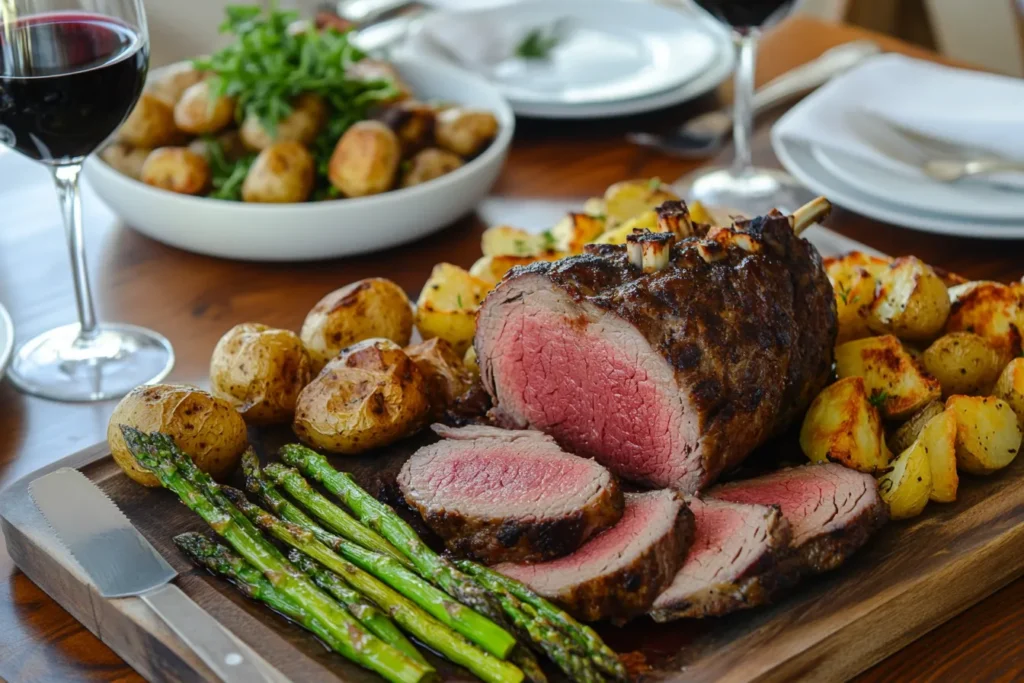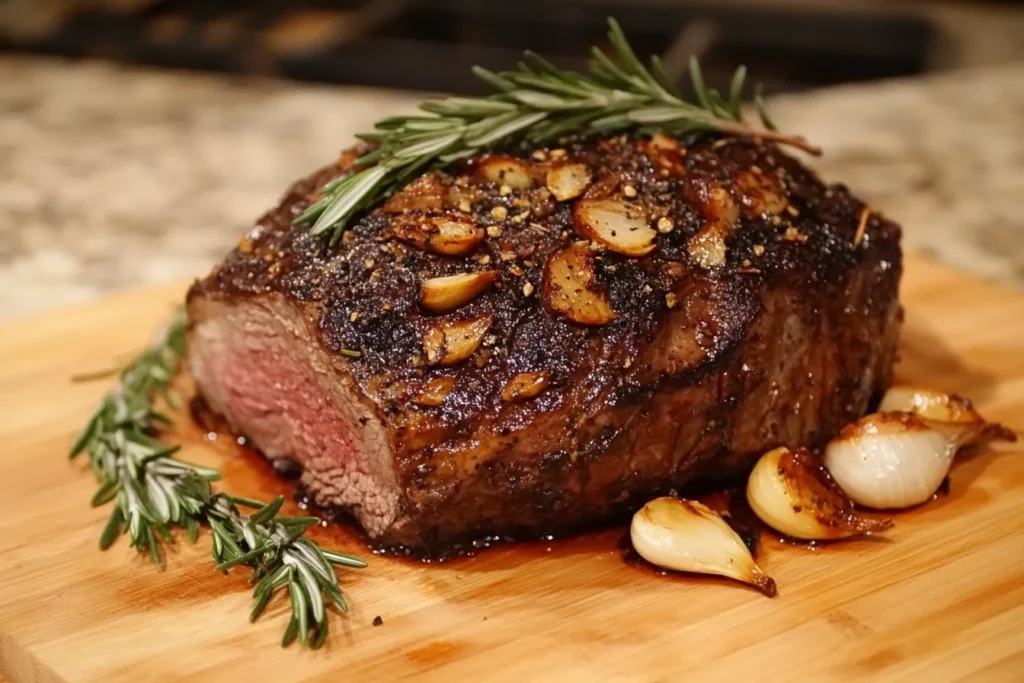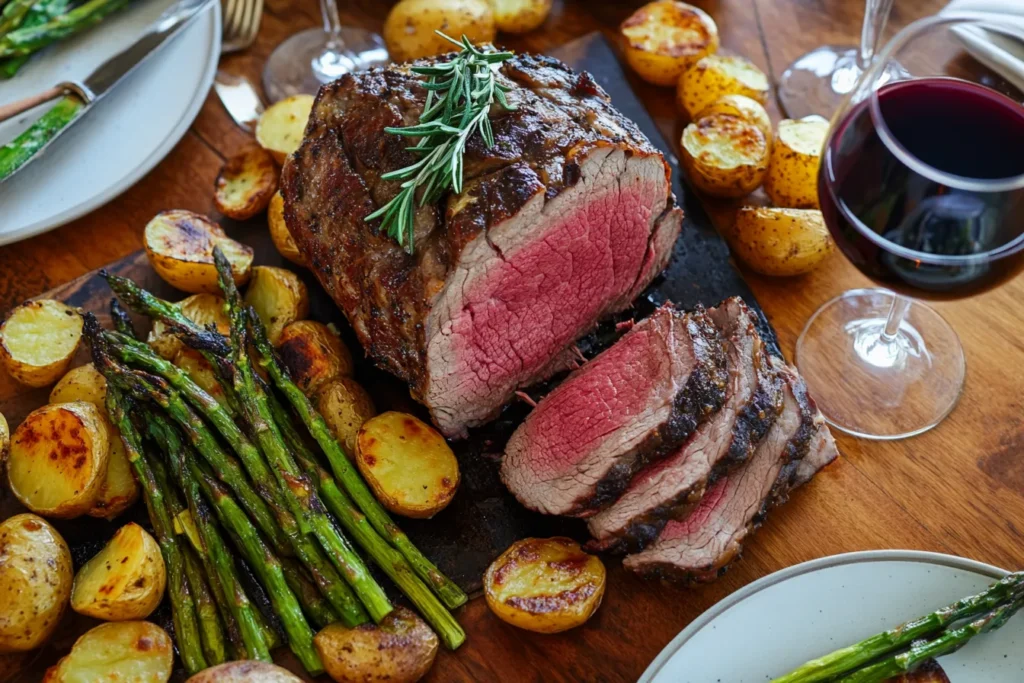Table of Contents
Is ribeye good for roasting? Absolutely! Roasting a ribeye is a fantastic way to create a stunning and flavorful centerpiece for any special occasion. It’s a relatively straightforward cooking method that yields impressive results.
Is Ribeye Good for Roasting? An In-Depth Look
The ribeye roast, also known as prime rib (though not all ribeye roasts are officially graded “Prime”), is prized for its rich marbling. This marbling renders during the roasting process, basting the meat from the inside out and contributing to its exceptional flavor and tenderness. Therefore, choosing a ribeye roast is a decision you won’t regret ( Is ribeye good for roasting?).
What Makes Ribeye Roasts Special?
The location of the ribeye cut along the cow’s rib section gives it its signature attributes. Because this muscle isn’t heavily worked, it remains tender. The abundance of intramuscular fat adds significantly to the flavor profile and creates a melt-in-your-mouth texture. Furthermore, the generous fat cap on top of the roast helps to keep the meat moist during cooking.

Understanding Grades of Ribeye
When selecting a ribeye roast, pay attention to the USDA grade. Prime, Choice, and Select are the common designations. Prime roasts have the most marbling, followed by Choice, and then Select. A higher grade typically translates to a more flavorful and tender roast. However, a well-prepared Choice roast can still be a delightful experience. Ultimately, the best choice depends on your budget and desired level of indulgence ( Is ribeye good for roasting?).
Mastering the Ribeye Roasting Process
Roasting a ribeye might seem intimidating, however, following a few key steps ensures a delicious outcome. From selecting the right roast to monitoring internal temperature, each stage plays a crucial role ( Is ribeye good for roasting?).
Choosing the Right Ribeye Roast
Selecting a quality ribeye roast is crucial. Look for even marbling throughout the meat and a good fat cap. The roast should feel firm to the touch, and the color should be a vibrant red. In addition, consider the size of the roast in relation to the number of people you’re serving. A good rule of thumb is about one pound per person.
Preparing the Ribeye for Roasting
Proper preparation is essential for optimal flavor and even cooking. Begin by removing the roast from the refrigerator at least two hours before cooking. This allows the meat to come closer to room temperature, promoting even cooking. Next, pat the roast dry with paper towels. This helps the surface to brown nicely during searing. Finally, season generously with salt, pepper, and any other desired herbs or spices. Garlic powder, onion powder, rosemary, and thyme are all excellent choices ( Is ribeye good for roasting?).
Searing: Optional but Recommended
Searing the ribeye roast before roasting is optional, however, it adds a delicious crust and enhances the flavor. Searing involves browning the surface of the meat in a hot pan or under a broiler. This process creates the Maillard reaction, which produces complex flavor compounds.
Roasting Techniques: Low and Slow vs. High Heat
There are two main roasting techniques: low and slow, and high heat. The low and slow method involves roasting the ribeye at a low temperature (around 250°F) for a longer period. This method results in a very tender and evenly cooked roast. The high heat method involves roasting the ribeye at a higher temperature (around 450°F) for a shorter period. This method produces a more pronounced crust and a slightly less evenly cooked interior ( Is ribeye good for roasting?).
Monitoring Internal Temperature
Accurately monitoring the internal temperature of the ribeye roast is crucial for achieving the desired level of doneness. Use a meat thermometer to check the temperature in the thickest part of the roast, avoiding bone. The following temperatures are general guidelines:
- Rare: 120-130°F
- Medium-Rare: 130-140°F
- Medium: 140-150°F
- Medium-Well: 150-160°F
- Well-Done: 160°F+
Resting: A Critical Step
Resting the ribeye roast after cooking is just as important as the roasting process itself. Allow the roast to rest for at least 20-30 minutes before carving. During this time, the juices redistribute throughout the meat, resulting in a more tender and flavorful roast. Tent the roast loosely with foil while it rests.
Enhancing the Flavor of Your Ribeye Roast
While a simple seasoning of salt and pepper is often sufficient, there are numerous ways to enhance the flavor of your ribeye roast. Consider using herbs, spices, marinades, or sauces to create a truly unique and memorable dish ( Is ribeye good for roasting?).
Herb and Spice Combinations
Experiment with different herb and spice combinations to find your favorite flavor profile. Rosemary and garlic are a classic pairing that complements the richness of the ribeye. Thyme, oregano, and paprika can add a touch of warmth and complexity. For a bolder flavor, consider adding a pinch of cayenne pepper or red pepper flakes ( Is ribeye good for roasting?).

Marinades and Rubs
Marinades and rubs can penetrate the meat and infuse it with flavor. A simple marinade can be made with olive oil, balsamic vinegar, garlic, and herbs. A dry rub can be made with salt, pepper, brown sugar, paprika, and other spices. Apply the marinade or rub at least a few hours before roasting, or even overnight for maximum flavor.
Sauces and Gravies
Serve your ribeye roast with a flavorful sauce or gravy to complete the dish. A classic au jus, made from the pan drippings, is a simple and elegant choice. A creamy horseradish sauce or a rich red wine reduction are also excellent options ( Is ribeye good for roasting?).
Is Ribeye Good for Roasting? Considering the Cost
Ribeye roasts can be a pricier cut of meat. Therefore, consider the cost when planning your meal. While the exceptional flavor and tenderness justify the expense for special occasions, you may want to explore alternative cuts for everyday meals.
Common Mistakes to Avoid When Roasting Ribeye
Even with the best intentions, mistakes can happen. Being aware of these potential pitfalls helps you avoid them and achieve a perfect ribeye roast every time.
Overcooking or Undercooking
The most common mistake is overcooking or undercooking the ribeye. Use a reliable meat thermometer and monitor the internal temperature closely. Remember that the roast will continue to cook slightly as it rests, so remove it from the oven when it’s a few degrees below your desired temperature.
Skipping the Resting Period
Skipping the resting period is another common mistake. This crucial step allows the juices to redistribute throughout the meat, resulting in a more tender and flavorful roast. Be patient and allow the roast to rest for at least 20-30 minutes before carving.
Not Seasoning Generously Enough
Don’t be afraid to season the ribeye roast generously. Salt and pepper are essential for enhancing the flavor of the meat. Consider adding other herbs and spices to create a more complex flavor profile.
Carving Incorrectly
Carving the ribeye roast correctly is important for maximizing tenderness. Use a sharp carving knife and slice against the grain. This will shorten the muscle fibers and make the meat easier to chew.

Is Ribeye Good for Roasting? Other Considerations
Beyond the cooking techniques, there are other factors to consider when roasting ribeye. These factors include the type of oven, the altitude, and the desired level of doneness.
Oven Type and Altitude Adjustments
Different oven types can affect cooking times. Convection ovens, for example, cook food faster than conventional ovens. Adjust the cooking time accordingly. Altitude can also affect cooking times. At higher altitudes, water boils at a lower temperature, which can lengthen cooking times.
Serving Suggestions for Your Roasted Ribeye
A perfectly roasted ribeye deserves to be served with equally delicious accompaniments. Consider serving it with classic side dishes such as roasted potatoes, steamed vegetables, or a fresh salad.
Classic Side Dishes
Roasted potatoes are a classic pairing with ribeye. Toss them with olive oil, salt, pepper, and herbs before roasting them until golden brown and crispy. Steamed vegetables, such as asparagus, broccoli, or green beans, provide a healthy and colorful contrast to the richness of the ribeye. A fresh salad, with a light vinaigrette dressing, can also help to balance the flavors.
Wine Pairings
Pair your ribeye roast with a full-bodied red wine, such as Cabernet Sauvignon, Merlot, or Zinfandel. These wines have the tannins and acidity to cut through the richness of the meat and complement its flavor.
The Ultimate Verdict: Is Ribeye Good for Roasting?
Is ribeye good for roasting? Absolutely, yes! With its rich marbling, tender texture, and robust flavor, ribeye is an exceptional choice for roasting. By following the tips and techniques outlined in this guide, you can create a truly memorable dining experience. From selecting the right roast to mastering the cooking process, each step contributes to the final result. Therefore, don’t hesitate to try roasting a ribeye for your next special occasion.
FAQ
ribeye roast recipe
There are numerous ribeye roast recipes online. A simple one involves seasoning the roast with salt, pepper, garlic powder, and rosemary. Sear it in a hot pan, then roast at 325°F until it reaches your desired internal temperature. Let it rest before carving.
Is a ribeye roast the same thing as prime rib?
The terms are often used interchangeably, however, technically, “prime rib” refers to a ribeye roast that has been graded “Prime” by the USDA. Not all ribeye roasts are Prime grade, but they are still excellent for roasting.
How is ribeye best cooked?
Ribeye is best cooked to medium-rare or medium. This allows the marbling to render and the meat to remain tender. Roasting, grilling, and pan-searing are all great cooking methods.
Should I sear a ribeye roast before cooking?
Searing is optional, however, it adds flavor and creates a nice crust. Sear the roast in a hot pan or under a broiler before roasting.

